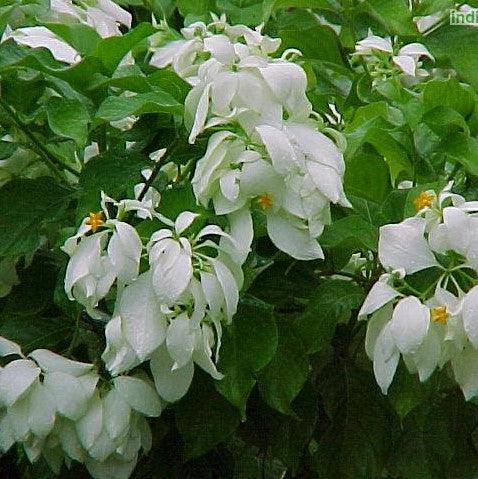- Common name:
- Mussaenda White
- Regional name:
- Marathi - Musanda Pandhara
- Category:
- Shrubs
- Family:
- Rubiaceae or Ixora and Pentas family
-
Introduction Mussaenda philippica, also known as White Mussaenda or Philippine Mussaenda, is an evergreen shrub native to the Philippines. It is popular for its stunning white, showy sepals and unique ornamental value. This guide will provide you with detailed instructions on how to grow, care for, and reap the benefits of this beautiful plant.
1. Planting Mussaenda philippica
-
1.1. Location: Choose a location with well-draining soil and partial to full sunlight. Avoid areas with harsh afternoon sun.
-
1.2. Soil: Plant in rich, well-draining soil with a pH between 6.0 and 7.5. Amend the soil with organic matter if necessary.
-
1.3. Spacing: Space plants about 3-5 feet apart to allow for proper air circulation and growth.
-
1.4. Planting Time: Plant in the spring or early summer, after the risk of frost has passed.
2. Caring for Mussaenda philippica
-
2.1. Watering: Water regularly, keeping the soil consistently moist but not waterlogged. Avoid overwatering to prevent root rot.
-
2.2. Fertilizing: Apply a balanced slow-release fertilizer every 3-4 months to promote healthy growth and abundant blooms.
-
2.3. Pruning: Prune after the flowering season to maintain shape and encourage bushiness. Remove dead or diseased branches as needed.
-
2.4. Pest and Disease Control: Inspect plants regularly for pests like aphids, mealybugs, and spider mites. Treat infestations with insecticidal soap or neem oil. Monitor for fungal diseases, such as leaf spot or powdery mildew, and apply a fungicide if necessary.
3. Benefits of Mussaenda philippica
-
3.1. Aesthetic Appeal: The white sepals create a striking contrast against the green foliage, adding visual interest to gardens and landscapes.
-
3.2. Pollinator Attraction: Mussaenda philippica attracts butterflies, bees, and other pollinators, promoting a healthy ecosystem in your garden.
-
3.3. Low Maintenance: This plant requires minimal care once established, making it an ideal choice for beginner gardeners or those with limited time.
4. Propagation
-
4.1. Cuttings: Take stem cuttings from healthy plants during the growing season, preferably with some new growth. Dip the cut end in rooting hormone, and place it in a well-draining potting mix. Keep the soil moist and provide indirect light until new growth emerges.
-
4.2. Seeds: Collect seeds from mature fruits and sow them in a well-draining seed-starting mix. Keep the soil moist and provide a warm environment for germination.
5. Conclusion Mussaenda philippica is a stunning, low-maintenance shrub that adds beauty and ecological value to any garden. By following this comprehensive guide, you can enjoy the rewards of growing and caring for this unique plant.



